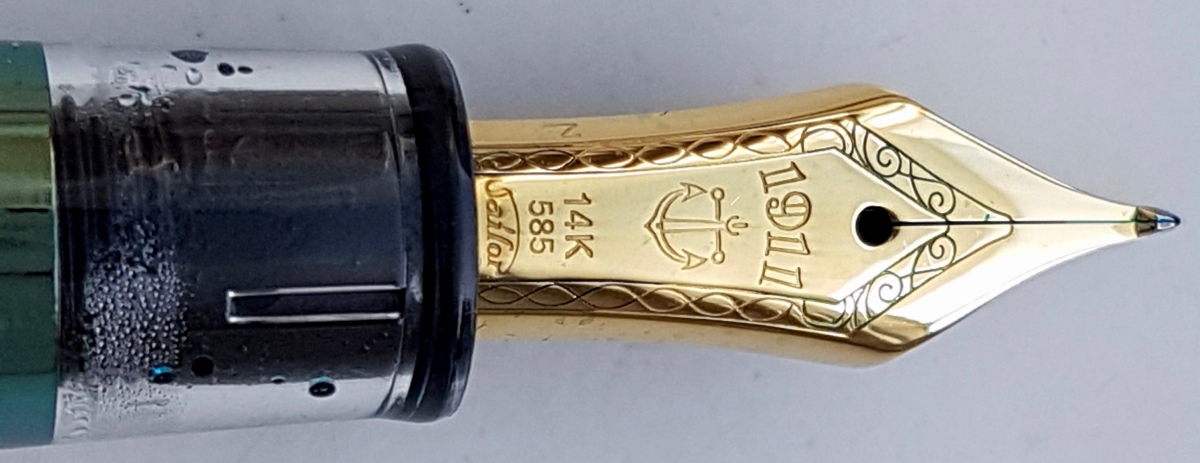Or, a careful step towards a Sailor Specialty Nib…
Oh, those Sailor specialty nibs… every now and again I will go through SBRE Brown’s Sailor nibs writing sample YouTube videos, or window shop in an online store, pretend-deciding which nib I would buy, if I could spend as much on a nib as on a bike…
But first things first. Let’s start with a short look at the brand. I’ve always wondered why Sailor is named “Sailor” and only took the trouble of looking that up when I did some research for this blogpost. The Sailor Japan website tells us that in 1911, a respected engineer by the name of Mr. Kyungoro Sakata, met with a British sailor who introduced him to the concept of the fountain pen. Mr. Sakata was so impressed with this tool, that he vowed to produce them in Japan with the best engineering and design possible. He started a fountain pen company in Hiroshima. This is still the company’s home town today.

Sailor offers a wide range of pens, from simple plastic bodies with steel nibs for school use or to get acquainted with fountain pens, up to collector’s items with artful Maki-E and Urushi lacquers. The nib range for most pens is quite versatile, from EF through Broad, Music and the enormous Zoom nib. But there is more… the Sailor company employs Master Nib Designer Nobuyoshi Nagahara, who has been with the company for over 60 years. He re-introduced the Naginata – Togi nib (“long sword”) and began combining multiple tipping points to arrive at nibs that have crossing ink slits to put down an impressive ink line. Stunning nibs that are great for hand-letterers and (Eastern) calligraphy artists. Not your everyday note taking nibs. But then again, why not? More about the nibs on the UK Sailor Pen page.
So now for the disappointing bit… I do not own or can show you the use of any of the specialty nibs. Believe me, I wish I could. I have had the immense fortune and pleasure to try some of a pen friends’s impressive Sailor collection during a pen meet – for which I am still grateful! Should you be reading this, Marco, many thanks for trusting those beauties to my trembling hands. What I came away with that nib tasting session that although I always thought a Cross Point would be at the top of my wishlist, but it got knocked off by a Cross Music nib. The even more narrow nib stroke of the Cross Music makes it more usable for everyday writing in my hand.
Anyhow, back to my first Sailor. After having ogled the SBRE Brown Sailor nib videos many many times and traipsing around the internet for good places to hunt for decently priced Sailors, I came across a video on YouTube of John Mottishaw, grinding a very different nib on a very different pen – a stub on a Pelican I believe – and took a look at the nibs.com site. I was happy to find decently priced Sailors with the possibility of an in-house nib grind and decided to go for a Sailor 1911 Standard Transparent with the zoom nib (check the tab Service Price List on the Nibs.com site, if you want to know more about their services), to be reground into an architect or Hebrew nib shape. The pen arrived about two weeks after placing the order and I was very impressed with that relatively short processing and shipping time.

The Sailor 1911 Standard is a relatively small pen, with a total capped length of 134 mm, a section width of 9 mm and the broadest part being the cap band with 14 mm. The pen is made of PMMA with gold-plated metal trimmings (which sort of clash with the steel of the converter, if you care about these matters) and weighs a mere 19.8 grams capped. The 14k nib comes in sizes EF, F, M, B, Music and Zoom. The Zoom was the basis for this regrind.

The pictures above give an impression of the regrind shape. The nib stroke gives you a thin down stroke and a wider side stroke, depending on how high or low you hold the section. A couple of writing samples, because those tell more than a thousand words (so I’m trying to keep this blog under 900 words, haha):
Holding the pen almost perpendicular to the paper
Holding the pen at a regular position on the section
Holding the pen rather flat to the paper, so very near where the section meets the body
This nib will be a joy if you like achieving different ink lines and seeing some versatility in your writing. This pen is nearly always in my daily carry, it is a wonderful pen for note taking as well as writing a special message with a bit of expression, even on paper that tends to feather. Then you just hold the pen a bit more towards the nib to get a thinner ink line.

One of my all time favorite writers and the inspiration to try my hand at grinding a couple of my easily replaceable steel nibs into architects, something I love trying my hand at every now and again. as you will no doubt have noticed if you follow me on Instagram.
As ever, thank you for reading and if you have any questions regarding the above or other writing matters, please like, comment or send me a message.

What a great post! This is the first one of yours I’ve had the pleasure of reading; it won’t be the last. I’ve got the Naginata-Togi Broad Nib and am still learning to use it properly. When it says broad, that’s exactly what it means.
LikeLiked by 1 person
Thank you for your appreciation! My pleasure and I hope to one day post on a specialty nib, preferably the Cross Music 😆. Enjoy using your broad Togi!
LikeLike
Great post Janine! I haven’t tried an architect nib yet, but it’s definitely on my list after seeing so many examples on your Instagram feed.
LikeLiked by 1 person
Thank you, Sharon! It’s worth trying one, so versatile.
LikeLike
Thank you for sharing your experience and these great pictures. Every time I look at them, it urges me to go the next step and try to get one of these pens. Sadly I did not have the opportunity to write with an architectnib yet.
LikeLiked by 1 person
This was my first writing experience with an architect nib as well, so I was kind of worried it would not work for me. But the nibs.come people are very helpful in getting you what you are looking for.
No affiliated, just favorable experience! 😃
LikeLiked by 2 people